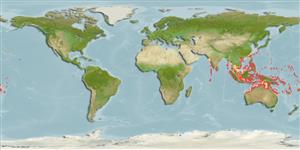Common names from other countries
Environment: milieu / climate zone / depth range / distribution range
Écologie
marin récifal; profondeur 4 - 46 m (Ref. 9710), usually 10 - 20 m (Ref. 27115). Tropical; 24°C - 28°C (Ref. 27115); 30°N - 24°S, 70°E - 171°W
Indo-Pacific: Maldives (Ref. 2334) to Samoa, north to the Ryukyu Islands, south to the southern Great Barrier Reef and New Caledonia.
Taille / Poids / Âge
Maturity: Lm ? range ? - ? cm
Max length : 8.0 cm TL mâle / non sexé; (Ref. 26587)
Épines dorsales (Total): 10; Rayons mous dorsaux (Total): 12; Épines anales 3; Rayons mous anaux: 6. This species possess numerous short filaments at the tip of each dorsal spine. Thickened and elongate lower pectoral rays.
Shallow coastal to outer reef flats and slopes to 45 m depth (Ref. 48636). Common inhabitant of coral reefs, typically resting at the bases of coral heads (Ref. 9710). Studies indicate that it is haremic and spawns nightly (Ref. 37816). Occasionally in pairs (Ref. 48636). Sometimes solitary (Ref 90102).
Life cycle and mating behavior
Maturité | Reproduction | Frai | Œufs | Fécondité | Larves
Pelagic spawner (Ref. 31569). Spawning ascents into the water column occurred over a distance of 0.2 to 0.6 m (Ref. 54536).
Randall, J.E., G.R. Allen and R.C. Steene, 1990. Fishes of the Great Barrier Reef and Coral Sea. University of Hawaii Press, Honolulu, Hawaii. 506 p. (Ref. 2334)
Statut dans la liste rouge de l'IUCN (Ref. 130435)
CITES (Ref. 128078)
Not Evaluated
Menace pour l'homme
Harmless
Utilisations par l'homme
Pêcheries: sans intérêt; Aquarium: Commercial
Plus d'informations
RéférencesAquacultureProfil d'aquacultureSouchesGénétiqueElectrophoresesHéritabilitéPathologiesTraitementMass conversion
Outils
Articles particuliers
Télécharger en XML
Sources Internet
Estimates based on models
Preferred temperature (Ref.
115969): 25.2 - 28.9, mean 27.8 (based on 206 cells).
Phylogenetic diversity index (Ref.
82804): PD
50 = 0.5039 [Uniqueness, from 0.5 = low to 2.0 = high].
Bayesian length-weight: a=0.01288 (0.00604 - 0.02750), b=2.99 (2.79 - 3.19), in cm Total Length, based on LWR estimates for this species & (Sub)family-body (Ref.
93245).
Niveau trophique (Ref.
69278): 4.0 ±0.65 se; based on food items.
Fishing Vulnerability (Ref.
59153): Low vulnerability (10 of 100).
